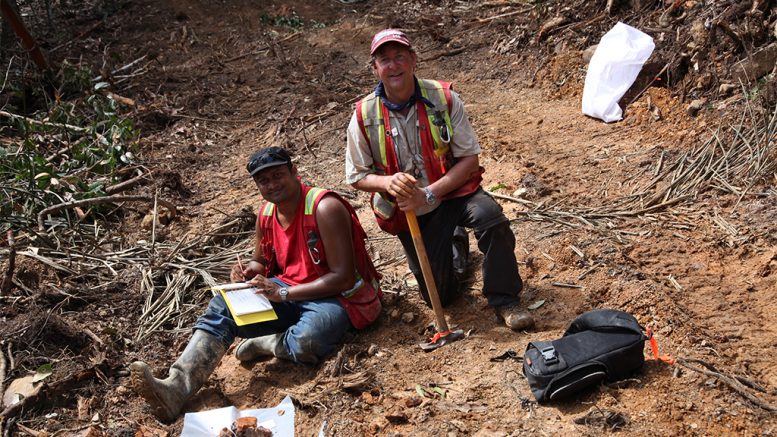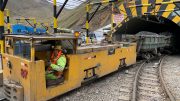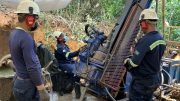79North (CSE: JQ; US-OTC: SVNTF) has made a new discovery at its 20,000 hectare Nassau gold project in Suriname, about 20 km south of Newmont’s (TSX: NGT; NYSE: NEM) Merian gold mine and 60 km east of Iamgold’s (TSX: IMG) Rosebel gold mine.
The new discovery called the Carbonara gold zone — mostly concealed by jungle — is contained in a quartz vein-like body that is at least 1,600 metres long and several metres wide, where gold grades from rock chip samples based on three widely spaced outcrops run up to 4.52 grams gold per tonne.
Founder and CEO Jon North says the silica alteration zone at Carbonara is one of the vastest deposits of hydrothermal quartz he has ever seen, “which is encouraging because every geologist knows that gold deposits are also quartz deposits.”
In addition, Carbonara is a northwest trending structure that is parallel to Newmont’s Merian deposit, which is northwest trending too, and its silica alteration looks like Merian’s, North says.

The helicopter pad and exploration crew at the Carbonara Grid. Credit: 79North.
“At one stage this area tied on to the Newmont exploration concession that became Merian, but they had to withdraw some of the concession because they had to negotiate a mining concession for Merian,” North says in an interview. “But it’s within trucking distance of Merian’s mill, and it’s closer to the mill than Newmont’s Sabajo deposit that they’re going to mine. It’s part of the same gold field.”
The Carbonara discovery is about eight km from the company’s Witlage target, which is also a northwest trending structure and according to North appears to be similar to the stratigraphy at Iamgold’s Rosebel deposit.
“The Rosebel stratigraphy goes right through the Witlage gold zone and that’s the contact of what’s basically a Timiskaming sequence — a coarse fluviatile sequence unconformably overlying a volcanic platform,” he explains. “It’s exactly the same as Rosebel, but Merian isn’t in that environment, it’s off on its own, it’s in a mixed sedimentary volcanic sequence. But the common ingredients are the dominance of northwest structural corridors.”
In January the company released results from the first 45 rock chip samples taken from the Witlage target, with assays of up to 27.98 grams gold per tonne.
Witlage and Carbonara are 79North’s first two drill targets, and North says he thinks the company will drill Carbonara first. “The size of Carbonara is so compelling and it’s continuous,” he says.
The Witlage target could turn out to be continuous as well, he adds, but so far it’s only been exposed over a strike length of about 300 metres and then it dips under tailings from where Brazilian artisanal miners have worked in the area, or it goes undercover of colluvium.
Carbonara, by contrast, is a high silica body that is holding up a very steep sloped ridge. North says his team can’t see that it is continuous because it hasn’t been working there long enough, but where it has been exposed, it fits in with the northwest trending structure thematic at the project, and has an underlying magnetic anomaly that “seems to represent the strike of the stratigraphy and every time we see it, it’s gold-bearing, so we think we know where it is because of the magnetic anomaly.”
The three gold occurrences found at Carbonara (called Brodino, Arrabiatta and Puttanesca) are on the edge of the magnetic anomaly. The question, North says, is what is the mag anomaly?
“Is it alteration? Is it an intrusion? Is it mineralized? Is it earlier, the same age or later age than the silica alteration? All those things need to be told.”
North says if they can establish that the mag anomaly is mineralized, and is related to the silica alteration and the source of all the alluvium, the company could use the mag anomaly to map out the initial drill holes. It could also be a sterile, younger diabase that’s magnetic.
The Toronto-based junior found gold at Carbonara even before it had finished the baseline for the grid. “Before the auger sampling or line-cutting was even done, we had found gold occurrences on this high silica alteration zone,” North says. “It left me wondering: This is massive silica and it’s everywhere on this steeply dipping ridge.”
“We finished looking at one of the exposures and while it looked like replacement quartz, it’s not a vein, and we went, ‘wow, this looks like silica lithocap, what is it doing in the Proterozoic, it doesn’t belong here, and why does it have so much gold in it’? The last time I was looking at this kind of silica lithocap was 15,000 km away from here in Burma.”

79North’s Nassau project in Suriname. Credit: 79North.
The interesting thing, North says, is that typically silica litho-caps generally don’t contain gold, so what has been found so far at Carbonara is not lithocap, it’s something else, and the nearest thing he could think of as a comparison is Barrick Gold’s (TSX: ABX; NYSE: GOLD) Morila deposit in Mali, which is silica replacement of a large volume of sediment.
“Morila is a beautiful gold deposit so that’s what we’re working off of — we’re working on the basis that it is this very continuous massive zone of silica alteration where gold is being concentrated. It’s going to take a lot of drilling but we know we have a gold deposit. The question now is: Is the deposit mineable, because of the size and grade and metallurgical characteristics that would make it possible.”
North is excited about the future.
“It just seems like we’ve got this large concession, in a regional gold field that contains Merian and Rosebel and in every way that is typical of the Guyana Gold Shield, where you get these large endowments of gold in small places,” he says. “When we went public and did the financing, the concept was these are the right rocks and we’re there for the right reasons. This is an immature place for exploration, a very different place than Western Australia, or the Timmins Camp, or Yellowknife, and there’s still room for discoveries.”
The mining executive also gives credit to the Brazilian artisanal miners for pinpointing places to start the hunt for gold. “We’re just following where the Brazilians are finding the alluvium and figuring out where the gold is coming from,” he says. “That was how Rosebel and Merian were found.”
The Brazilians are really good gold miners, he adds. They only care about the alluvium and drive into the jungle with an excavator, get onto water courses, drive along the creeks and every 10 or 20 metres they take a couple of scoops out of the creeks, pan it, count the colours, and decide whether to mine there or keep going.
On his first trip to Suriname in July 2016, North recalls, “there was nothing going on up there, it was a no-man’s land, jungle.” But since then, “a large number of Brazilian artisanal miners have shown up, did prospecting and started mining all the gravels out of the creeks that were draining this topographic and magnetic anomaly, so we said, ‘Nature is trying to tell us something, it’s the source of the gold.’”





Be the first to comment on "79North reports new gold discovery at Nassau project in Suriname"